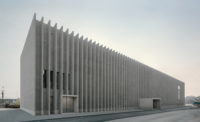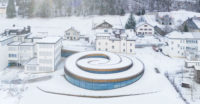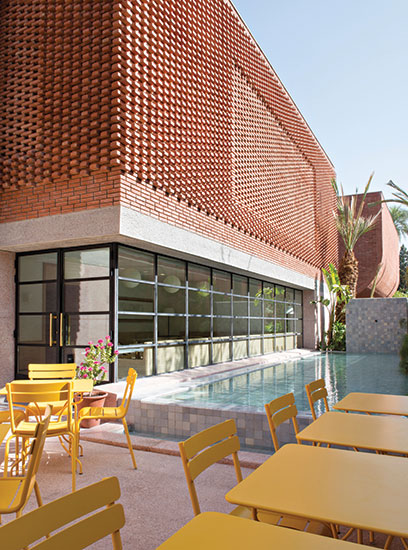Musée Yves Saint Laurent by Studio KO
Marrakech, Morocco

The two-story building features highly articulated brick walls over a terrazzo base.
Photo © Nicolas Mathéus

The two-story building features highly articulated brick walls over a terrazzo base.
Photo © Nicolas Mathéus

Yves Saint Laurent in Marrakech’s medina quarter.
Photo © Reginald Gray

An exhibition highlights the work of French painter Jacques Majorelle in Morocco.
Photo © Nicolas Mathéus

A research library is located on the second level.
Photo © Nicolas Mathéus

The circular entrance patio features a diagonal pattern.
Photo © Nicolas Mathéus

The brick pattern of the front facade is carried over to the back, where there is a terrace for the café.
Photo © Nicolas Mathéus

Image courtesy Studio KO

Image courtesy Studio KO









Architects & Firms
Commissioned by Pierre Bergé, Yves Saint Laurent’s longtime life and business partner—who died just a month before its opening in October—the Musée Yves Saint Laurent in Morocco pays homage to the work of the legendary couturier. Located a stone’s throw from the Villa Majorelle, the couple’s Marrakech home, it occupies a cramped site in a zone where planning regulations restrict building height to just two stories. The architects, Studio KO (Karl Fournier and Olivier Marty), had no choice but to fill the plot up to its perimeter. The facade is almost entirely blind. This is because, on the one hand, the principal internal spaces—galleries for both the permanent and temporary exhibitions, a quarantine room for incoming objects, basement reserves, and a small auditorium for both concerts and lectures—require the exclusion of daylight, and, on the other, because Studio KO chose to echo the traditional North African house, which, hiding from the street, is organized around internal patios.
Additional Content:
Jump to credits & specifications
So the question arose of how to articulate the perimeter envelope. “The last thing Pierre wanted was an architectural ‘icon,’ but rather a building that was of its time and place,” recalls Fournier. “There are two main materials that dress the museum’s facade: brick and terrazzo. Both are produced locally by Moroccan craftsmen. We wanted materials that were handsome and hard-wearing but that weren’t ostentatious—unlike many of the rather showy glass buildings that are currently going up in Marrakech, which not only ignore tradition but also common sense in a city where summer temperatures can exceed 120 degrees Fahrenheit. We also liked the idea of a contrast between ‘poor’ materials on the outside and the richness of the haute couture within.”
The museum’s perimeter walls take the form of a three-layer sandwich: the first layer comprises both concrete panels cast in situ and a column-and-beam concrete structure with industrial-brick infill; then comes a layer of mineral-wool insulation; and finally the outer skin, whose lower part is terrazzo (rising 7½ feet above grade) and whose upper part is specially made red terra-cotta brick. “We wanted the building to appear as though lifted off the ground,” says Fournier, “which is what prompted the use of terrazzo. Both the sidewalk and the lower part of the facade are in the same material. The joint where they meet is curved, like a cape draped on the floor.” Made from an aggregate comprising marble gravel with cement and pigment mortar, the 1 3/16 inch-thick terrazzo was poured in place on the sidewalk but prefabricated for the joint and the wall cladding, so as to ensure the required precision. Easy to clean and rework in the event of graffiti, the terrazzo base also puts the delicate brickwork of the facade’s upper part out of reach.
The hand-laid clay bricks—which were fired in the northern Moroccan town of Tétouan in various sizes to allow complex corner joints—are arranged in three-dimensional geometric patterns that were hand-drawn by the architects, some pure invention, others inspired by historic buildings, including a minaret in Iran. Life-size mock-ups were created to test the patterns, which catch light in different ways according to the time of day. Capping the facade is a strip of brass—unlacquered, so that it will dull and patinate with time—while just above the terrazzo is a string course in bush-hammered raw concrete which, integrated into the column-and-beam structure, carries the bricks above. “We’d done tryouts and weren’t convinced by having the brick sit directly on the terrazzo,” recalls Fournier. “We also wanted to express the reality of the construction, but we weren’t sure what surface treatment to give the concrete string course. We’d tried a wood-plank finish, but the results were too uneven. Quite by chance, Olivier happened upon workmen on-site who were chiseling away at a newly cast concrete wall. We realized that revealing the aggregate would be the perfect finish for this Brutalist belt that encircles the entire building. Pierre loved it and said it reminded him of Marcel Breuer’s New York Whitney building.”
CreditsArchitect: Studio KO — Karl Fournier, Olivier Marty, founding partners; Fayçal Tiaïba, project manager
Architect of record: Claire Patteet
Engineers Bymaro (structural, civil, mechanical) General contractor: Bymaro
Client: Fondation Jardin Majorelle |
SpecificationsDoors Mogs
Glazing Saint-Gobain
Acoustic panels Topakustik |
















